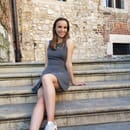I have taken courses and read quite a lot on World War II and the holocaust, but seeing where the horrors took place was something else entirely. I knew it would be difficult to take in, but I feel it is a responsibility to learn and see what happened in the concentration camps. I had so many thoughts going through my head during the tour of Auschwitz-Birkenau. I was very reflective and overall sad, which I expected, but what I did not expect was how angry I felt at some points. I am typically slow to anger, but seeing Birkenau Extermination Camp and learning some of the things the Nazis did made me feel so angry, especially looking at the remains of the crematoria and looking at how they tried to hide what they did from the world.
“Just following orders,” so many people claimed. Orders from their leaders. It pains me to think that so many people could follow such orders. How could they let them take precedence over the orders from God: Orders to not kill, orders to not steal, orders to not lie, and orders to love thy neighbor?
There was so much in the camps and museums that shocked me. The piles of hair they had displayed was horrible, as well as the piles of shoes that were taller than me and as long as the hallway. All I could think about was all that hair belonged to a person; it was physically a part of a human being that was taken away from them, and now it is all that remains. Someone walked in each of those pairs of shoes, and there was a story behind each shoe. One of the worst sights for me was a display case that showed a toddler’s outfit. I had to look away because it was very distressing. Those clothes were on a baby who was likely ripped from her mother and killed without a second thought. The child who wore those clothes could not have been older than my niece.
It was such a beautiful day. The sky was bright and blue and the grass was green. It felt so wrong that anything in the area could be alive or beautiful. The new grass never knew the horrors of the buildings it grows around. The world moves on around the dilapidated buildings. Moss grows around the charred and twisted remains of the crematoria. But the buildings remain fixed, as testaments to the suffering of millions. It felt wrong to be walking around the empty camp, to enter freely, and it felt wrong to be able to just walk out because so many others were never able to leave.
Pictured: Remains of the building where millions were exterminated by the Nazis.
Image Courtesy: Halie Lewin
It was a difficult thing to see, and this reflection is difficult to write and read, but it’s important to see, write, and read to remember and to never forget.


